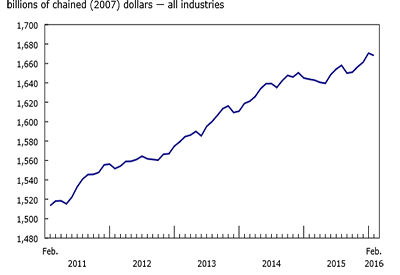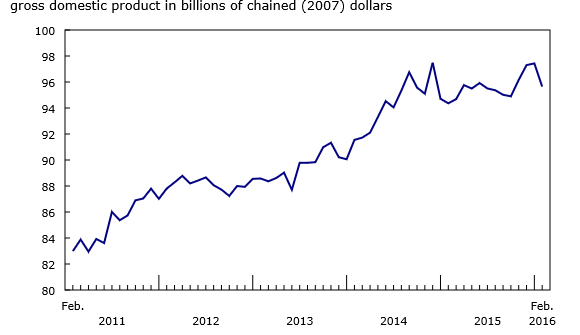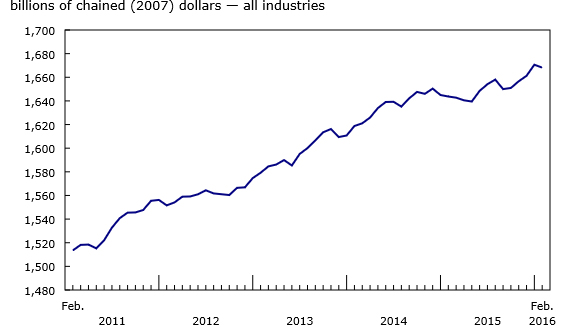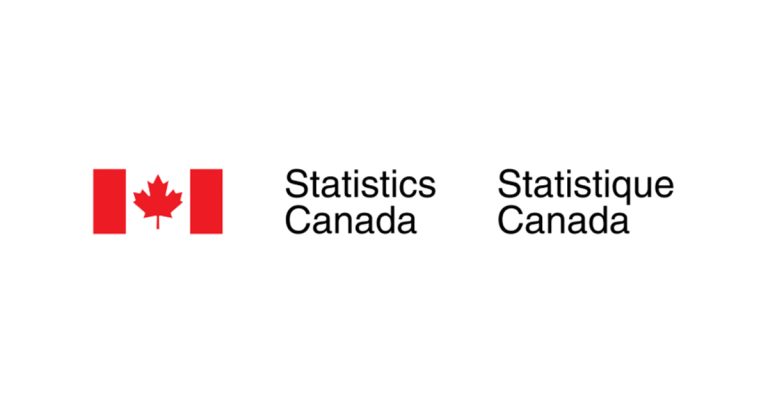Gross domestic product by industry, February 2016

May 2 2016
After rising for four consecutive months, real gross domestic product edged down 0.1% in February. The output of goods-producing industries declined in February, while the output of service-producing industries was essentially unchanged.
After increasing 0.9% in January, the output of goods-producing industries contracted 0.6% in February primarily as a result of decreases in manufacturing and mining, quarrying, and oil and gas extraction. Declines were also registered in the agriculture and forestry sector as well as in utilities. Construction edged up.
The output of service-producing industries was essentially unchanged in February, after rising for four consecutive months. A notable decline in wholesale trade was offset by gains in retail trade and, to a lesser extent, the public sector (education, health and public administration combined) and accommodation and food services.
Chart 1: Real gross domestic product edges down in February
Wholesale trade contracts while retail trade expands
Wholesale trade contracted 1.8% in February after rising the previous three months. Most subsectors were down. The largest decline in terms of output came from wholesalers of machinery, equipment and supplies, followed by the motor vehicles and parts and building material and supplies subsectors.
Chart 2: Wholesale trade contracts in February

Retail trade expanded 1.4% in February, after rising 1.6% in January. Notable increases were posted at clothing and clothing accessories stores, food and beverage stores, and general merchandise stores (which include department stores).
Manufacturing output falls
After rising the previous three months, manufacturing output fell 0.8% in February.
Durable-goods manufacturing was down 1.8% in February, after expanding for three consecutive months. The decline in February was mainly the result of a decrease in transportation equipment manufacturing, which was widespread across the subsector. The manufacturing of wood products, computer and electronic products, and furniture and related products was also down. In contrast, fabricated metal product manufacturing, primary metal manufacturing, machinery manufacturing and electrical equipment manufacturing were up.
Non-durable goods manufacturing rose 0.4%, a third consecutive monthly increase. This was the result of a gain in chemical manufacturing, mainly pharmaceutical and medicine manufacturing. In contrast, petroleum and coal products manufacturing and, to a lesser extent, food manufacturing posted declines.
Mining, quarrying, and oil and gas extraction declines
Mining, quarrying, and oil and gas extraction declined 0.8% in February, after increasing 1.0% in January.
Following a 1.9% increase in January, support activities for mining and oil and gas extraction retreated 5.1% in February as a result of declines in rigging and drilling services.
After expanding for four consecutive months, oil and gas extraction contracted 0.6%, mainly as a result of a 1.7% decline in non-conventional oil extraction. Conventional oil and gas extraction increased 0.4%.
Mining and quarrying (excluding oil and gas extraction) grew 0.5% as a result of an increase in metal ore mining. Decreases were registered in non-metallic mineral and coal mining.
Construction edges up
Construction edged up 0.1% in February. Repair construction and residential building construction increased, while non-residential building and engineering construction declined. For non-residential building construction, it was the seventh consecutive monthly decrease.
The output of real estate agents and brokers grew 1.5% as a result of increased activity in the home resale market.
The public sector edges up
The public sector (education, health and public administration combined) edged up 0.1% in February. Public administration and educational services were up, while health care services were down.
The finance and insurance sector edges up
The finance and insurance sector edged up 0.1% in February. Banking and insurance services increased, while financial investment services declined.
Other industries
Accommodation and food services rose 0.7%, as the increase in accommodation services outweighed a decline in the food services and drinking places industry.
Transportation and warehousing services declined 0.2% in February, after rising 1.1% in January. Lower pipeline transportation output contributed to the decrease.
Utilities decreased 0.2% in February. Natural gas distribution fell 3.8% as a result of declines in distribution across all customer types. The output of the electric power generation, transmission and distribution industry rose 0.4%.
Source: Statistics Canada, www.statcan.gc.ca/daily-quotidien/160429/dq160429a-eng.htm?cmp=mstatcan.












